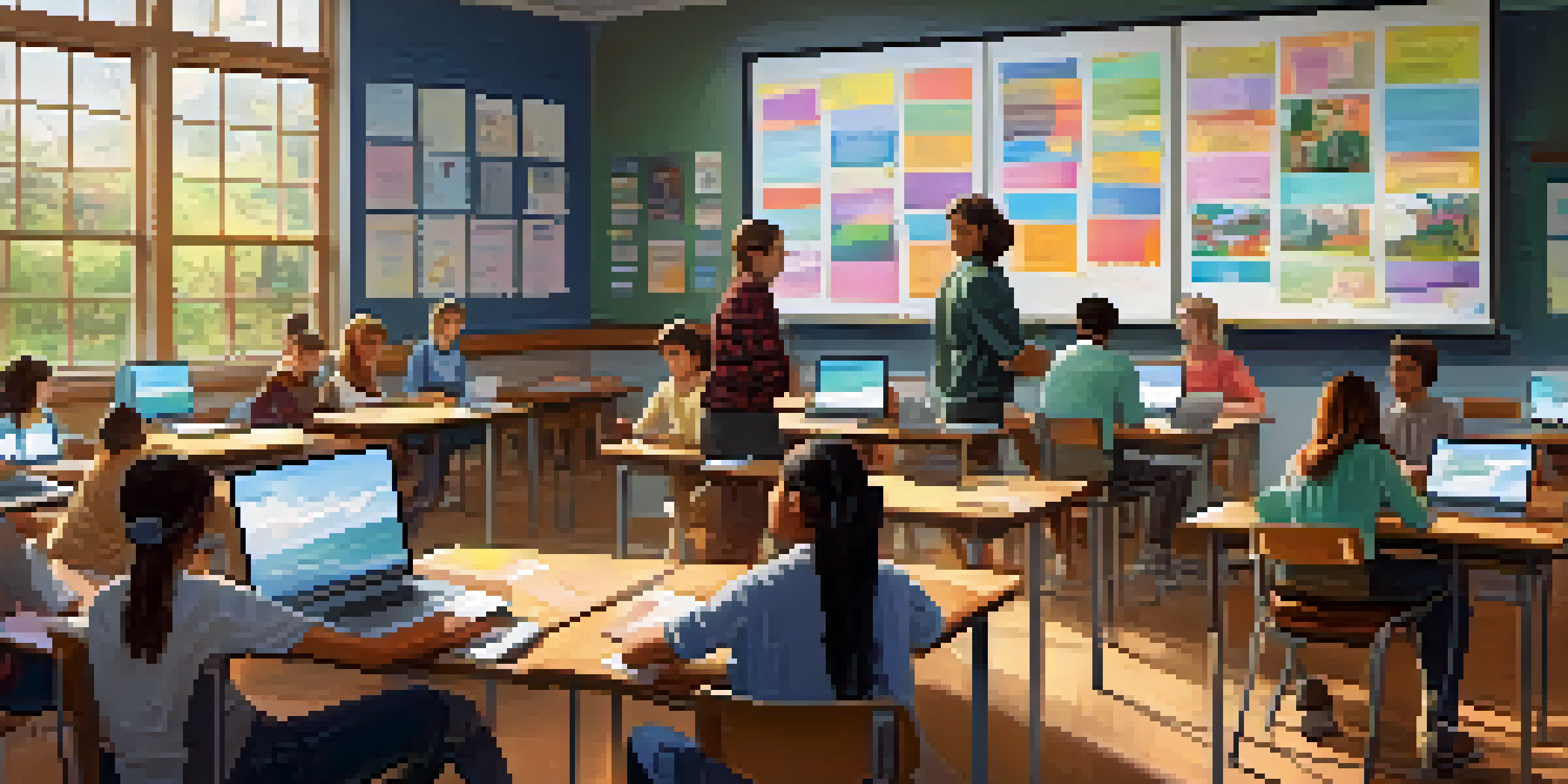Fostering Digital Collaboration Among Educators and Students

Understanding the Importance of Digital Collaboration
Digital collaboration is vital in today's educational landscape, facilitating communication and teamwork between educators and students. It allows for a more interactive learning experience, where students can engage with peers and instructors in real-time, regardless of their physical location. By embracing digital tools, educators can create a dynamic atmosphere that encourages creativity and innovation.
The greatest danger in times of turbulence is not the turbulence; it is to act with yesterday's logic.
Moreover, fostering digital collaboration helps students develop essential skills for the modern workforce. Skills such as problem-solving, critical thinking, and effective communication are enhanced when students work together on projects using digital platforms. This collaboration not only benefits academic growth but also prepares students for future career challenges.
Finally, digital collaboration can help build a sense of community within the classroom. When students and educators collaborate online, it breaks down barriers and encourages a more inclusive environment. This sense of belonging can significantly impact student motivation and engagement, leading to better educational outcomes.
Choosing the Right Digital Tools for Collaboration
Selecting the appropriate digital tools is crucial for successful collaboration in education. Platforms like Google Classroom, Microsoft Teams, and Zoom offer various features tailored for educational settings, allowing for seamless communication and resource sharing. It's essential to consider the specific needs of your class when choosing tools, as different platforms may support different types of collaboration.

In addition to traditional video conferencing tools, consider using collaborative document editing platforms like Google Docs. These tools allow multiple users to work on the same document simultaneously, making it easier for students to contribute their ideas and feedback. This real-time collaboration nurtures a sense of teamwork and enhances critical thinking skills.
Digital Tools Enhance Collaboration
Choosing the right digital tools fosters effective communication and teamwork among students and educators.
Don't forget to involve students in the decision-making process when choosing digital tools. By allowing them to voice their preferences, you not only empower them but also ensure that the tools selected resonate with their learning styles. Engaging students in this way fosters ownership and encourages them to utilize the tools to their fullest potential.
Establishing Clear Guidelines for Digital Collaboration
To ensure effective collaboration, it's essential to establish clear guidelines for digital interactions. Setting expectations regarding communication, participation, and collaboration can help create a positive online learning environment. These guidelines can include rules on respectful communication and how to provide constructive feedback to peers.
Collaboration allows teachers to capture each other's fund of collective intelligence.
Additionally, it's helpful to outline specific roles and responsibilities for each group member during collaborative projects. By clarifying who is responsible for what, you can prevent confusion and ensure that all students contribute to the group’s success. This structure not only streamlines the collaboration process but also helps students develop accountability.
Moreover, revisiting these guidelines periodically can help reinforce their importance. Frequent check-ins can encourage students to communicate openly about any challenges they encounter while collaborating. This approach fosters a culture of continuous improvement and adaptability, essential qualities in a digital landscape.
Encouraging a Culture of Open Communication
Open communication is the backbone of successful digital collaboration. Encouraging students to express their thoughts and ideas freely can lead to richer discussions and more innovative solutions. Creating a safe space for dialogue allows students to feel valued and understood, which boosts their confidence and willingness to collaborate.
Implementing regular feedback sessions is one way to promote open communication. These sessions can provide students with opportunities to share their experiences and discuss any challenges they face during collaborative tasks. By fostering an environment where feedback is welcomed, educators can help students improve their collaborative skills over time.
Guidelines Promote Effective Interaction
Establishing clear guidelines helps create a positive online learning environment and encourages accountability.
Furthermore, leveraging various communication channels can enhance engagement. Whether through discussion boards, chat features, or video calls, offering multiple ways for students to connect can cater to diverse communication preferences. This variety not only keeps collaboration fresh but also strengthens the overall learning experience.
Integrating Collaborative Projects into the Curriculum
Integrating collaborative projects into the curriculum is an effective way to enhance digital collaboration. Projects that require teamwork can help students apply theoretical knowledge in practical scenarios, making learning more meaningful. For instance, group research projects or creative presentations can encourage students to share their unique perspectives and expertise.
Moreover, real-world applications of collaborative projects can significantly boost student engagement. When students see the relevance of their work beyond the classroom, they are more likely to invest effort into the collaboration. For example, partnering with local organizations for community projects can instill a sense of purpose and responsibility in students.
In addition, incorporating technology into collaborative projects can enrich the learning experience. Using digital platforms for collaboration allows students to explore different tools and resources, enhancing their technological proficiency. This integration prepares them for future academic and professional challenges, making them more adaptable in an ever-evolving digital world.
Fostering Inclusivity in Digital Collaboration
Inclusivity is a key element in fostering effective digital collaboration among diverse student groups. It's essential to recognize and appreciate the varied backgrounds and perspectives that each student brings to the table. By promoting an inclusive environment, educators can ensure that all voices are heard and valued, enriching the collaborative experience for everyone involved.
To foster inclusivity, consider implementing activities that encourage collaboration among students with different skill sets and experiences. Mixed-ability groupings can help students learn from one another, while also promoting empathy and understanding. These interactions can lead to stronger relationships and a more cohesive classroom community.
Inclusivity Enriches Learning Experiences
Fostering inclusivity ensures diverse perspectives are valued, enhancing the collaborative experience for all students.
Additionally, providing various ways for students to contribute can make a significant difference. Some students may feel more comfortable sharing their ideas through written communication, while others may prefer verbal discussions. By accommodating different communication styles, educators can ensure that every student feels empowered to participate actively in collaborative efforts.
Evaluating the Impact of Digital Collaboration
Evaluating the effectiveness of digital collaboration is crucial for continuous improvement. Regular assessments can help educators identify strengths and areas for growth, ensuring that collaborative efforts meet educational goals. Feedback from students can be particularly valuable, offering insights into their experiences and challenges during collaborative projects.
Consider implementing both formative and summative assessments to gauge student learning outcomes. Formative assessments can provide ongoing insights, while summative assessments can evaluate overall project success. This comprehensive approach helps educators refine their strategies and enhance collaboration in future projects.

Moreover, celebrating successes in digital collaboration can motivate students. Highlighting outstanding projects or innovative teamwork can inspire other students to engage more actively in their collaborative efforts. By recognizing achievements, educators can foster a positive atmosphere that encourages continuous participation and collaboration.